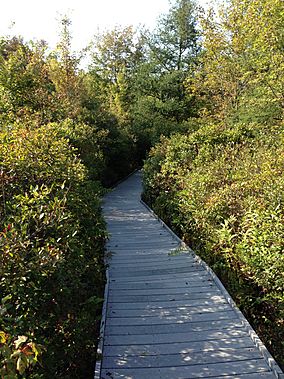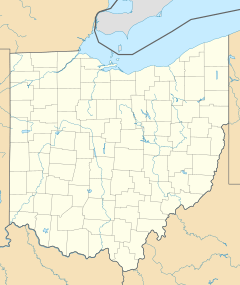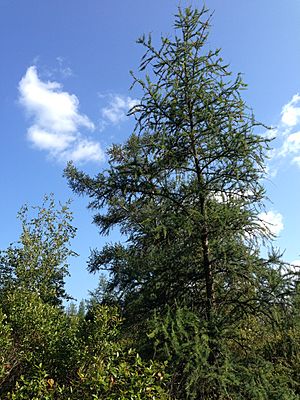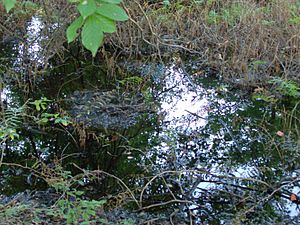Tom S. Cooperrider-Kent Bog State Nature Preserve facts for kids
Quick facts for kids Tom S. Cooperrider-Kent Bog State Nature Preserve |
|
|---|---|
| Kent Bog | |
 |
|
| Location | Kent, Ohio |
| Area | 45 acres (18 ha) |
The Tom S. Cooperrider - Kent Bog State Nature Preserve is a special natural area. It is mostly found in Kent, Ohio. This preserve protects the Kent Bog, which is a unique wetland. It was formed a very long time ago by a huge ice sheet called the Wisconsin Glaciation.
A "bog" is a type of wetland with very acidic water. These special conditions allow unique plants to grow there. The Kent Bog is home to the largest group of tamarack trees in all of Ohio.
Contents
Discover the Kent Bog Preserve
The Kent Bog is located at 1028 Meloy Road. It covers about 45.1 acres (18.3 ha) of land. The first part of the preserve, about 41.7 acres (16.9 ha), was bought by the Ohio Department of Natural Resources (ODNR) in 1985. This part is in Kent. Later, in 2008, ODNR added another 3.4 acres (1.4 ha) in nearby Brimfield Township.
Right next to the preserve, there's a 215-acre (87 ha) park being created. It's a great place to explore nature!
Exploring the Boardwalk Trail
At the preserve, you'll find a parking lot. From there, a half-mile long boardwalk trail begins. This boardwalk loops around the bog, bringing you back to the parking lot. Along the way, there are signs that teach you about the plants, animals, and how the bog was formed.
The preserve was officially opened in 1987. It is named after Tom S. Cooperrider. He was a botanist and a professor at Kent State University. He studied the bog and Ohio's plants for many years. His book, Botanical Essays from Kent, talks a lot about the Kent Bog.
How the Kent Bog Was Formed
The Kent Bog was created by the Wisconsin Glacier. This was a giant sheet of ice that covered much of North America. As the glacier melted and moved back, a large piece of ice broke off. This ice chunk got buried under dirt and rocks.
A ridge of sediment formed around this buried ice. When the ice finally melted, it left a deep hole in the ground. This type of hole is called a kettle hole. The original lake in this kettle hole was about 50 acres (20 ha) big.
From Lake to Bog
As the weather got warmer, plants began to grow over the lake. A special type of plant called sphagnum moss started to cover the water. This moss is very important for bogs.
Over time, the lake slowly filled up with peat. Peat is made from dead plants that don't fully decay because of the acidic water. This process turned the lake into the bog we see today. From the boardwalk, you can still see small areas of standing water.
Plants and Animals of the Kent Bog
The Kent Bog is like a boreal forest, which is a type of cold, northern forest. It has many spruce, fir, and tamarack trees.
The Unique Tamarack Tree
The tamarack tree is very special. It is common in cold places like Canada and Alaska. Tamaracks can handle very cold temperatures. Unlike most other conifers (trees with needles), the tamarack is deciduous. This means it loses its needles in the winter, just like many broadleaf trees lose their leaves. This makes the Kent Bog look different in each season. The group of tamarack trees in the Kent Bog is the largest in Ohio!





